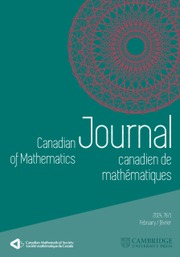No CrossRef data available.
Article contents
A Generalization of Degree Two Simple Finite-Dimensional Noncommutative Jordan Algebras
Published online by Cambridge University Press: 20 November 2018
Extract
Let  be an algebra over a field
be an algebra over a field  . For x, y, z in
. For x, y, z in  , write (x, y, z) = (xy)z – x(yz) and x-y = xy + yx. The attached
, write (x, y, z) = (xy)z – x(yz) and x-y = xy + yx. The attached  algebra is the same vector space as
algebra is the same vector space as  , but the product of x and y is x · y. We aim to prove the following result.
, but the product of x and y is x · y. We aim to prove the following result.
THEOREM 1. Let  be a finite-dimensional, power-associative, simple algebra of degree two over a field of prime characteristic greater than five. For all x, y, z in
be a finite-dimensional, power-associative, simple algebra of degree two over a field of prime characteristic greater than five. For all x, y, z in  , suppose
, suppose
1
Then  is noncommutative Jordan.
is noncommutative Jordan.
The proof of Theorem 1 falls into three main sections. In § 3 we establish some multiplication properties for elements of the subspace  in the Peirce decomposition
in the Peirce decomposition  . In §4 we construct an ideal of
. In §4 we construct an ideal of  which we then use to show that the nilpotent elements of
which we then use to show that the nilpotent elements of  form a subalgebra of
form a subalgebra of  for i = 0, 1.
for i = 0, 1.
Information
- Type
- Research Article
- Information
- Copyright
- Copyright © Canadian Mathematical Society 1980

